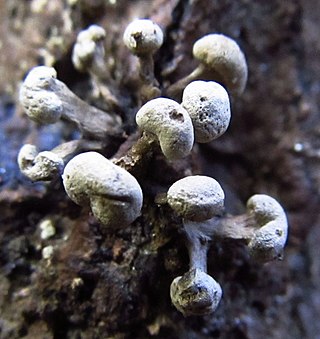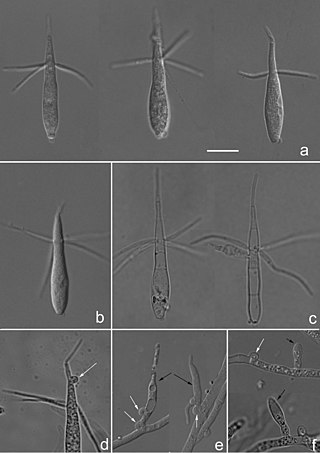
The Ustilaginomycotina is a subdivision within the division Basidiomycota of the kingdom Fungi. It consists of the classes Ustilaginomycetes and Exobasidiomycetes, and in 2014 the subdivision was reclassified and the two additional classes Malasseziomycetes and Monilielliomycetes added. The name was first published by Doweld in 2001; Bauer and colleagues later published it in 2006 as an isonym. Ustilagomycotina and Agaricomycotina are considered to be sister groups, and they are in turn sister groups to the subdivision Pucciniomycotina.

The Agaricostilbomycetes are a class of fungi in the subdivision Pucciniomycotina of the Basidiomycota. The class consists of a single order, six families, and 15 genera. Its type genus, Agaricostilbum was originally placed in Ascomycota, and later, Agaricomycotina, before being placed in Pucinniomycotina.

The Atractiellomycetes are class of fungi in the Pucciniomycotina subdivision of the Basidiomycota. The class consists of a single order, the Atractiellales, which contains 3 families, 10 genera, and 58 species.

The Classiculomycetes are a class of fungi in the Pucciniomycotina subdivision of the Basidiomycota. The class contains a single order, the Classiculales, which in turn contains the single family Classiculaceae. The family contains two monotypic genera.
The Cryptomycocolacomycetes are a class of fungi in the Pucciniomycotina subdivision of the Basidiomycota. The class contains a single order, the Cryptomycocolacales, which in turn contains the single family Cryptomycocolacaceae. The family has two monotypic genera.
The Cystobasidiomycetes are a class of fungi in the subdivision Pucciniomycotina of the Basidiomycota. Most species are known from their yeast states; hyphal states, when present, produce auricularioid basidia and are frequently parasites of other fungi. The class contains five orders as well as two families and one genus (Queiroziella) of uncertain disposition. An additional order, Cyphobasidiales, has been proposed to accommodate several lichenicolous species, but its separation from the Erythrobasidiales has not been demonstrated.

The Microbotryomycetes are a class of fungi in the subdivision Pucciniomycotina of the Basidiomycota. The class currently contains eight orders, plus three additional, unassigned families, plus seven additional, unassigned genera. Many species are known only from their yeast states. Species with hyphal states typically produce auricularioid basidia and are often parasitic on other fungi or plants. Several species in the genera Rhodotorula and Sporobolomyces are opportunistic human pathogens.

The Mixiomycetes are a class of fungi in the Pucciniomycotina subdivision of the Basidiomycota. The class contains a single order, the Mixiales, which in turn contains a single family, the Mixiaceae that circumscribes the monotypic genus Mixia. Only one species has been described to date, Mixia osmundae; this species was originally named Taphrina osmundae by Japanese mycologist Toji Nishida in 1911. It is characterized by having multinucleate hyphae, and by producing multiple spores on sporogenous cells.

Pucciniomycetes is a diverse class of fungi in the subphylum Pucciniomycotina of phylum Basidiomycota. The class contains 5 orders, 21 families, 190 genera, and approximately 8,016 species. It has been estimated that this class contains about one third of all teleomorphic basidiomycetes. Pucciniomycetes contains many economically important plant pathogenic fungal rusts; the order Pucciniales is the largest clade in this class, representing approximately 7,000 species.

The Helicobasidiales are an order of fungi in the subdivision Pucciniomycotina. The order is currently monotypic, containing the single family Helicobasidiaceae which itself is monotypic, containing the single genus Helicobasidium. The anamorphic genus Tuberculina is a synonym of Helicobasidium, but species are not currently integrated in the latter genus.

Eocronartium muscicola is a species of fungus belonging to the order Platygloeales. It is currently the only species in the monotypic genus Eocronartium. In the UK its recommended English name is moss rust. The species forms clavarioid basidiocarps on mosses, on which it is parasitic.

The Platygloeales are an order of fungi in the class Pucciniomycetes. Species in the order have auricularioid basidia and are typically plant parasites on mosses, ferns, and angiosperms, though Platygloea species appear to be saprotrophic.
The Spiculogloeomycetes are a class of fungi in the subdivision Pucciniomycotina of the Basidiomycota. The class consists of a single order, the Spiculogloeales, together with an additional, unassigned genus, Meniscomyces. Many species are currently known only from their yeast states. Species in the genus Spiculogloea form hyphal states that produce auricularioid basidia and are parasitic on other fungi.
The Spiculogloeales are an order of fungi in the subdivision Pucciniomycotina of the Basidiomycota. The order is currently monotypic, consisting of a single family, the Spiculogloeaceae. Species in the genus Phyllozyma are currently known only from their yeast states. Species in the genus Spiculogloea form hyphal states that produce auricularioid basidia and are parasitic on other fungi.
The Platygloeaceae are a family of fungi in the class Pucciniomycetes. Species in the family have auricularioid basidia and are typically plant parasites on angiosperms, though Platygloea species appear to be saprotrophic.
Naohidea sebacea is a species of fungus in the order Naohideales. The order is currently monotypic, having only one family, one genus, and one species. Basidiocarps of Naohidea sebacea form small, gelatinous pustules on wood-inhabiting species of Botryosphaeriaceae. Microscopically, they produce long, slender, auricularioid basidia and amygdaliform (almond-shaped) basidiospores.
The Cystobasidiaceae are a family of fungi in the order Cystobasidiales. The family currently comprises two genera, both of which contain fungal parasites with auricularioid basidia, some of which are known only from their yeast states.
The Cystobasidiales are an order of fungi in the class Cystobasidiomycetes. The order currently consists of a single family (Cystobasidiaceae) and two genera as yet unassigned to a family.

The Eocronartiaceae are a family of fungi in the class Pucciniomycetes. Species in the family have auricularioid basidia and are typically plant parasites on ferns and mosses.
Platygloea is a genus of fungi belonging to the class Pucciniomycetes. Basidiocarps of the type species are disc-shaped, gelatinous, and occur on dead wood, probably as a saprotroph. Microscopically, all species of Platygloea sensu lato have auricularioid basidia. Currently the genus contains a heterogeneous mix of auricularioid fungi not yet accommodated in other genera.









